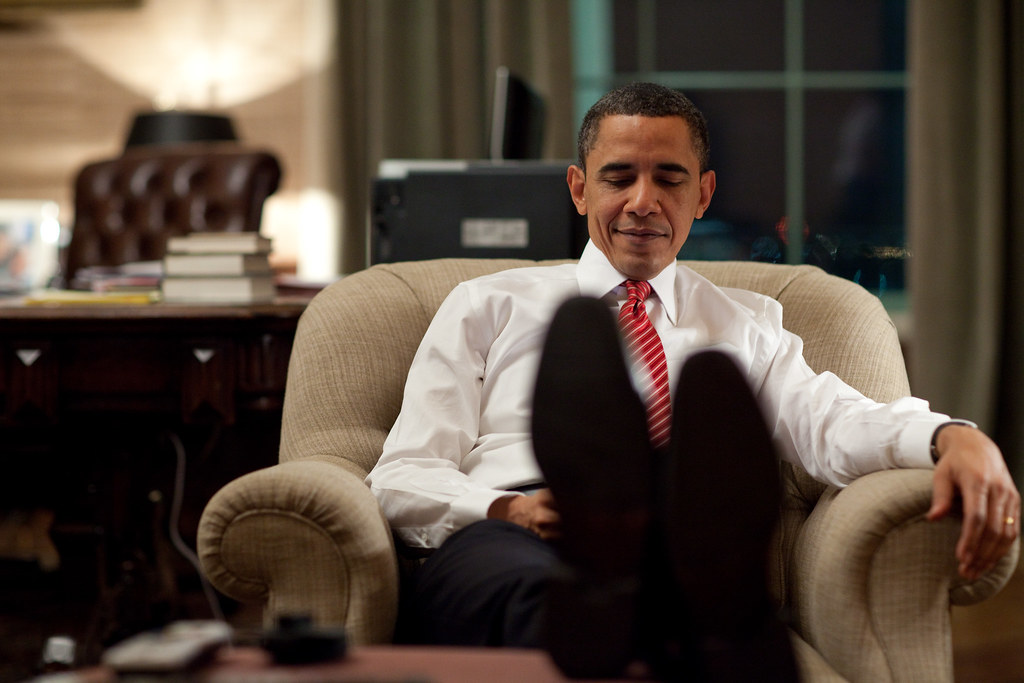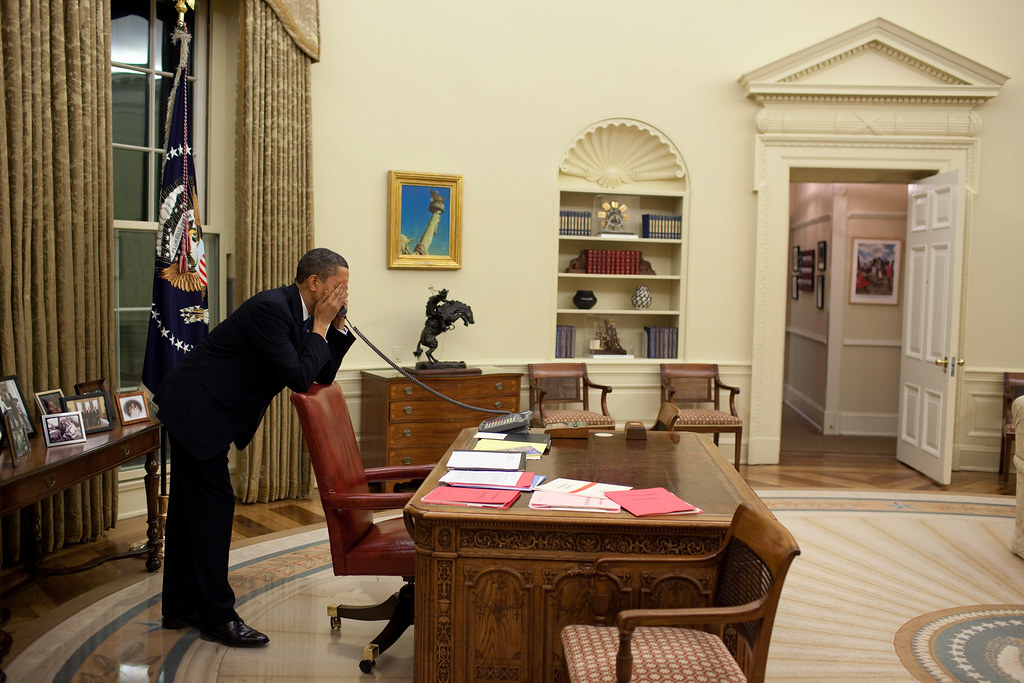Sounds about like Joe. But I don't see how you can tell what he said just from that audio - maybe they've already analyzed the sound? Or maybe my computer just sucks.
Health Care Reform Bill Passes - Now What?
by BizzyBee 118 Replies latest jw friends
-
-
leavingwt
Sounds about like Joe. But I don't see how you can tell what he said just from that audio - maybe they've already analyzed the sound? Or maybe my computer just sucks.
You need to really crank up the volume. He clearly says it. You won't miss it.
-
SixofNine
Secretary of State Hillary Rodham Clinton congratulates President Barack Obama on the House vote to pass health care reform, prior to a meeting in the Situation Room of the White House, March 22, 2010. (Official White House Photo by Pete Souza)
2
President Barack Obama reacts to a BlackBerry message in the Treaty Room office in the private residence of the White House, March 21, 2010. (Official White House Photo by Pete Souza)
3
President Barack Obama celebrates with staff on the Truman Balcony of the White House, early March 22, 2010, following the House vote to pass health care reform. (Official White House Photo by Pete Souza)
4
President Barack Obama pumps his fists during a meeting with senior staff in the Chief of Staff 's office at the White House, March 21, 2010. (Official White House Photo by Pete Souza)
5
President Barack Obama hugs Phil Schiliro, assistant to the President for Legislative Affairs, during a reception at the White House, early March 22, 2010. (Official White House Photo by Pete Souza)
6
President Barack Obama greets House Speaker Nancy Pelosi and her grandson, following a meeting with Democratic Members of Congress to discuss the health insurance reform vote at the U.S. Capitol in Washington, D.C., March 20, 2010. (Official White House Photo by Pete Souza)
7
President Barack Obama fist-bumps a medical professional in the Green Room of the White House, prior to the start of a health care event, March 3, 2010. (Official White House Photo by Pete Souza)
8
President Barack Obama holds a lucky charm given to him during the campaign, while on the phone with a Member of Congress in the Oval Office, March 21, 2010. (Official White House Photo by Pete Souza)
9
President Barack Obama calls a Member of Congress to discuss health care reform in the Oval Office, March 19, 2010. (Official White House Photo by Pete Souza)
10
President Barack Obama calls a Member of Congress to discuss health care reform in the Oval Office, March 19, 2010. (Official White House Photo by Pete Souza) -
leavingwt
Health Care Reform Myths
Myth
Truth
1. This is a universal health care bill. The bill is neither universal health care nor universal health insurance.
Per the CBO:
- Total uninsured in 2019 with no bill: 54 million
- Total uninsured in 2019 with Senate bill: 24 million (44%)
2.Insurance companies hate this bill This bill is almost identical to the plan written by AHIP, the insurance company trade association, in 2009. The original Senate Finance Committee bill was authored by a former Wellpoint VP. Since Congress released the first of its health care bills on October 30, 2009, health care stocks have risen 28.35%.
3. The bill will significantly bring down insurance premiums for most Americans. The bill will not bring down premiums significantly, and certainly not the $2,500/year that the President promised.
Annual premiums in 2016, status quo / with bill:
Small group market, single: $7,800 / $7,800
Small group market, family: $19,300 / $19,200
Large Group market, single: $7,400 / $7,300
Large group market, family: $21,100 / $21,300
Individual market, single: $5,500 / $5,800 *
Individual market, family: $13,100 / $15,200 *
4. The bill will make health care affordable for middle class Americans. The bill will impose a financial hardship on middle class Americans who will be forced to buy a product that they can’t afford to use. A family of four making $66,370 will be forced to pay $5,243 per year for insurance. After basic necessities, this leaves them with $8,307 in discretionary income — out of which they would have to cover clothing, credit card and other debt, child care and education costs, in addition to $5,882 in annual out-of-pocket medical expenses for which families will be responsible.
5. This plan is similar to the Massachusetts plan, which makes health care affordable. Many Massachusetts residents forgo health care because they can’t afford it. A 2009 study by the state of Massachusetts found that:
- 21% of residents forgo medical treatment because they can’t afford it, including 12% of children
- 18% have health insurance but can’t afford to use it
6. This bill provide health care to 31 million people who are currently uninsured. This bill will mandate that millions of people who are currently uninsured must purchase insurance from private companies, or the IRS will collect up to 2% of their annual income in penalties. Some will be assisted with government subsidies. 7. You can keep the insurance you have if you like it. The excise tax will result in employers switching to plans with higher co-pays and fewer covered services. Older, less healthy employees with employer-based health care will be forced to pay much more in out-of-pocket expenses than they do now.
8. The “excise tax” will encourage employers to reduce the scope of health care benefits, and they will pass the savings on to employees in the form of higher wages. There is insufficient evidence that employers pass savings from reduced benefits on to employees. 9. This bill employs nearly every cost control idea available to bring down costs. This bill does not bring down costs and leaves out nearly every key cost control measure, including: - Public Option ($25-$110 billion)
- Medicare buy-in
- Drug reimportation ($19 billion)
- Medicare drug price negotiation ($300 billion)
- Shorter pathway to generic biologics ($71 billion)
10. The bill will require big companies like WalMart to provide insurance for their employees The bill was written so that most WalMart employees will qualify for subsidies, and taxpayers will pick up a large portion of the cost of their coverage. 11. The bill “bends the cost curve” on health care. The bill ignored proven ways to cut health care costs and still leaves 24 million people uninsured, all while slightly raising total annual costs by $234 million in 2019. “Bends the cost curve” is a misleading and trivial claim, as the US would still spend far more for care than other advanced countries.
In 2009, health care costs were 17.3% of GDP.
Annual cost of health care in 2019, status quo: $4,670.6 billion (20.8% of GDP)
Annual cost of health care in 2019, Senate bill: $4,693.5 billion (20.9% of GDP)
12. The bill will provide immediate access to insurance for Americans who are uninsured because of a pre-existing condition. Access to the “high risk pool” is limited and the pool is underfunded. It will cover few people, and will run out of money in 2011 or 2012 Only those who have been uninsured for more than six months will qualify for the high risk pool. Only 0.7% of those without insurance now will get coverage, and the CMS report estimates it will run out of funding by 2011 or 2012.
13. The bill prohibits dropping people in individual plans from coverage when they get sick. The bill does not empower a regulatory body to keep people from being dropped when they’re sick. There are already many states that have laws on the books prohibiting people from being dropped when they’re sick, but without an enforcement mechanism, there is little to hold the insurance companies in check.
14. The bill ensures consumers have access to an effective internal and external appeals process to challenge new insurance plan decisions. The “internal appeals process” is in the hands of the insurance companies themselves, and the “external” one is up to each state.Ensuring that consumers have access to “internal appeals” simply means the insurance companies have to review their own decisions. And it is the responsibility of each state to provide an “external appeals process,” as there is neither funding nor a regulatory mechanism for enforcement at the federal level. 15. This bill will stop insurance companies from hiking rates 30%-40% per year. This bill does not limit insurance company rate hikes. Private insurers continue to be exempt from anti-trust laws, and are free to raise rates without fear of competition in many areas of the country. 16. When the bill passes, people will begin receiving benefits under this bill immediately Most provisions in this bill, such as an end to the ban on pre-existing conditions for adults, do not take effect until 2014. Six months from the date of passage, children could not be excluded from coverage due to pre-existing conditions, though insurance companies could charge more to cover them. Children would also be allowed to stay on their parents’ plans until age 26. There will be an elimination of lifetime coverage limits, a high risk pool for those who have been uninsured for more than 6 months, and community health centers will start receivingmoney.
17. The bill creates a pathway for single payer. Bernie Sanders’ provision in the Senate bill does not start until 2017, and does not cover the Department of Labor, so no, it doesn’t create a pathway for single payer. Obama told Dennis Kucinich that the Ohio Representative’s amendment is similar to Bernie Sanders’ provision in the Senate bill, and creates a pathway to single payer. Since the waiver does not start until 2017, and does not cover the Department of Labor, it is nearly impossible to see how it gets around the ERISA laws that stand in the way of any practical state single payer system.
18 The bill will end medical bankruptcy and provide all Americans with peace of mind. Most people with medical bankruptcies already have insurance, and out-of-pocket expenses will continue to be a burden on the middle class. - In 2009, 1.5 million Americans declared bankruptcy
- Of those, 62% were medically related
- Three-quarters of those had health insurance
- The Obama bill leaves 24 million without insurance
- The maximum yearly out-of-pocket limit for a family will be $11,900 (PDF) on top of premiums
- A family with serious medical problems that last for a few years could easily be financially crushed by medical costs
http://fdlaction.firedoglake.com/2010/03/19/fact-sheet-the-truth-about-the-health-care-bill/
-
snowbird
Two-Third, from where do you find those pictures?
Sylvia
-
Farkel
:Health Care Reform Bill Passes - Now What?
Repeal, if we're lucky.
16,000 brand new hired IRS agents after your blood, if we're not.
Farkel
-
leavingwt
49% sounds a little high to me. However, a new CNN poll says 51% disapprove of Obama's job performance. So, the Rasmussen number might be accurate.
49% of Voters Support State Lawsuits Against Health Care Plan
No doubt about it, we Americans are an ornery, litigious bunch.
-
SixofNine
lol, Gibbs just tweeted "And yes Mr. Vice President, you're right"
-
SixofNine
Two-Third, from where do you find those pictures?
-
snowbird
Your organization's Internet use policy restricts access to this web page at this time.
Reason:
The Websense category "Social Networking and Personal Sites" is filtered.
URL:









